
MODULE 9 - CALLING ELK
CHAPTER 2: MY "GO-TO" ELK CALLING SEQUENCE

Before I dive into this section, I want to stress that elk calling does not work 100% of the time. Additionally, there is no elk calling strategy that works 100% of the time. It is important to be ready and able to adapt to every situation you are faced with. With that being said, my degree in Mechanical Engineering has taught me the value of efficiency. I spent the first 10 years of my professional, adult life, working on making systems and processes the most efficient they could be. That training and mindset absolutely transferred over to the rest of my life, including elk hunting.
When I step into the woods, I want a simple process that will create multiple opportunities, and I want to be able to capitalize as efficiently as possible on every one of them. I hear stories every season of elk hunters who called in 31 bulls, but never got an opportunity to fill their tag. That is definitely not me, and it does not align with my train of thought. If I call in 5 bulls, there had better be a bloodtrail before the 6th one! J Of course, it doesn’t always work out that way, but I do strive to find the most effective and efficient setups and opportunities I can.
So, the strategy I use to call in elk has been simplified and fine-tuned to be the most efficient calling tactic I can find. Again, it isn’t going to work every time on every bull, but it is the tactic that has brought me the most success on a consistent basis, and it is the one I turn to just about every time I step into the elk woods.
Simplicity is a very important factor in my life. If a process has multiple steps where failure could occur, then the likelihood of failure goes way up. If you can simplify a process and remove as many “links” as possible, that process will become much more robust and the likelihood of failure drops significantly. Besides being efficient, my elk calling strategy is incredibly simple, which eliminates many opportunities where I might otherwise mess up and fail. Additionally, the calls that I use for this tactic are very simple, which enables me – or you – to be completely confident in our calling abilities.
Going back to the previous Chapter when I talked about playing to the emotions of an elk, my go-to strategy for calling in elk is efficient, simple, and it speaks directly to an elk’s emotional response. It really doesn’t matter what the attitude of the bull is, or if it’s pre-rut or peak rut. My sequence for calling in elk remains the same, and it only requires three simple elk calls: the Location Bugle, the Cow Call, and the Challenge Bugle.
STEP #1 – GET CLOSE
I truly believe that the effectiveness of calling in an elk goes up with every step you are able to take toward the elk before you start calling. When speaking to the emotional response of an elk, what you say carries a lot more meaning as you get closer. Regardless of whether you want to bring the bull in to sweet cow calls, or a challenging fight, your “words” will have a much greater impact as you get closer to the one you are “speaking” to.
During my hunts, I spend the day hiking through as much country as possible, trying to locate an elk with a Location Bugle. Refer back to Module 5 for what a Location Bugle sounds like, but it is a simple, easy to make bugle that broadcasts an announcement throughout an area. I typically hike ridgetops where my bugles will reach the most country possible, and give a location bugle at every vantage point I come to. Once I get a response, I pinpoint the bull’s location as best as possible, and then I silently move towards the bull.
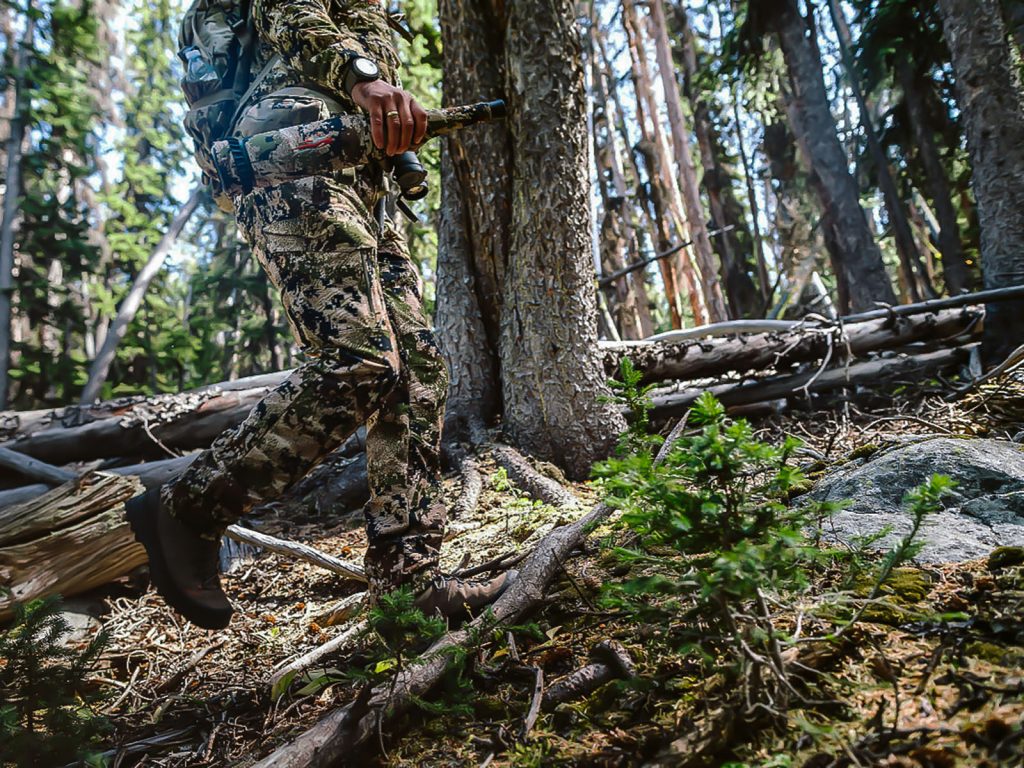
Sometimes, the bull will continue bugling, which will enable me to slip in really close. Other times, I may need to give a couple of cow calls during my approach to get another response and further pinpoint where the bull is. However, I DO NOT want to bugle as I am making my approach. If possible, I want the full element of surprise when I get close, but if that isn’t possible, I never want the bull to know another bull is getting close to him until I am set up and ready.
HOW CLOSE IS CLOSE ENOUGH?
I try to get inside 150 yards. That usually isn’t too difficult, but terrain and other conditions (quietness of ground, size of herd, etc.) will usually dictate just how close I can get. There have been times when I have slipped within 60 yards of a bull, and with a caller 40 yards behind me, that call-in was a slam dunk. Other times, I have been forced to set up over 200 yards from the bull. And while those set ups aren’t as “easy” as the closer ones, they can still work. Again, with every step you are able to take to get closer to an elk before you start calling, the odds of that elk coming in to your calls goes up significantly. A word of caution though…if you push too far and bump the elk, that setup is usually over. Not only do you lose the element of surprise, but you also alert the elk to potential danger. As a general rule of thumb, work in as close to the elk as you feel comfortable, and then find a good setup.STEP #2 – GET SET UP
Remember, at this point in the process, you are still in control. The elk does not know you are there, so take a few extra seconds to make sure your setup is ideal. If it isn’t, find a better place to set up. It will do you no good to bring the bull in on a string, if he comes in to a setup where you have limited or no shooting lanes. Make sure you go back and re-read the Module on Setting Up, and try to create a setup that will make the bull feel comfortable to come in to. Again, having a caller set up 40-60 yards behind the shooter is ideal, and will allow the shooter to set up and “vanish” from the bull’s radar. The shooter needs to be absolutely silent during the setup so that the elk never becomes aware of anything out in front of the “elk” that is calling to him from behind. Get as much on the same level as the elk as possible. Make sure you remember the A.R.C. (set up on the downwind side of the imaginary line from the elk to the caller) and Always Remember Concealment. Make sure the elk is not going to see, hear, or smell the shooter as it approaches the caller. Range a few landmarks along natural shooting lanes where the elk is going to be most likely to approach from. Once you are set up, this is where the action gets intense!STEP #3 – WORK THE CALLS
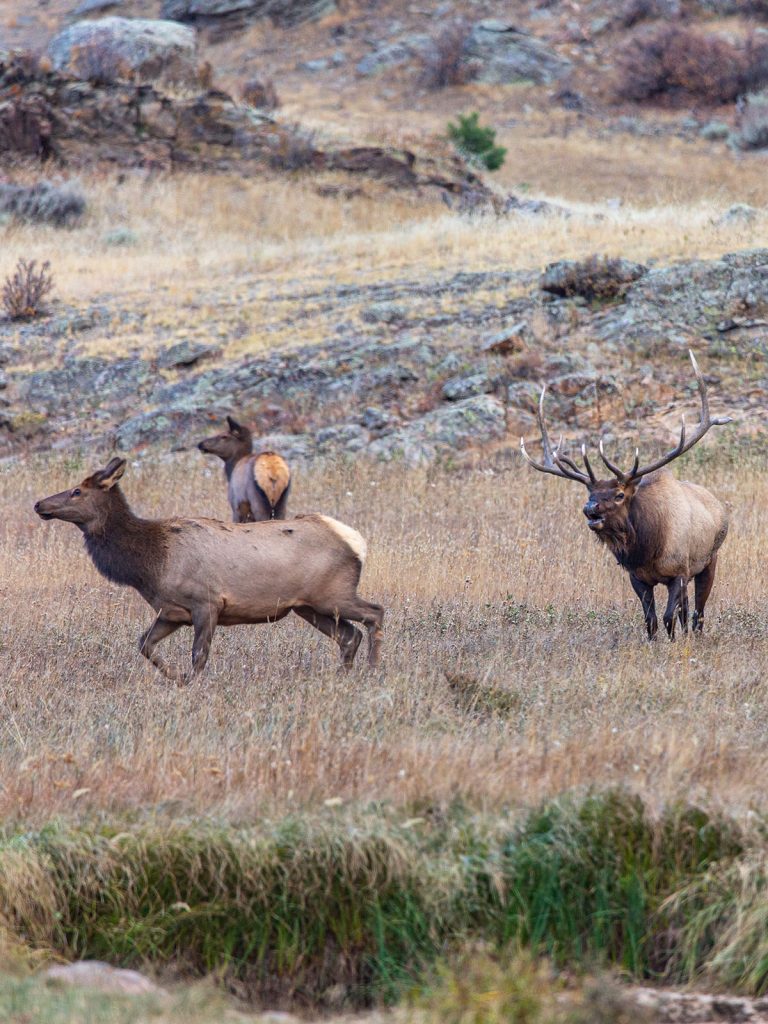
With the shooter set up out in front of the caller, the work load now lands squarely on the caller’s shoulders. It is the caller’s responsibility to get the bull into the shooter’s setup. Again, the way I approach this is simple. In fact, I only use two elk calls to deliver this tactic. Despite the simplicity, or possibly because of it, this tactic has been incredibly effective.
THE COW CALLS
I start out with two soft, clear cow calls. I’m not talking anything hyper-hot or super-estrous – just a normal, simple cow call. I want to make sure the bull hears it clearly, and knows exactly what it is. I am also totally OK if he knows exactly where it is coming from. It is the rut. Even the most pressured and call-shy bull will usually respond to a cow call from close by, especially if it catches him off-guard. Once he responds, I have a choice to make. I have to decide if I want to trigger his emotional desire to breed or to fight. This is where reading the attitude of the bull is important. If the bull has been bugling consistently as I made my approach, I tend to lean more towards the fighting side. If he’s been pretty timid and quiet, I might try more to capture his attention with cow calls. If I decide to go with cow calls, I will continue giving him 2-3 clear cow calls every 45-60 seconds. After 2-3 series of this, I should be able to tell if the bull is hanging back where he was, or if he is coming in. Sometimes, he will come in silent, so it’s important to listen intently for snapping twigs, footsteps, etc. If the bull bugles every time I cow call and is coming in, my work is easy. If he is silent for 2-3 series of cow calls, however, my fighting side starts to come out.THE CHALLENGE BUGLE
If the bull has been aggressive or very vocal as I make my approach, I usually go straight to the fight scenario. Or, if I start out with a less aggressive, cow-call only approach (as I mentioned above) and the bull isn’t acting too interested, I’ll switch gears and jump right into the fighting strategy. I’ve found that a vocal bull does not like to have a challenger close to him, especially if I can throw in a couple additional emotional triggers. Here is how I trigger the bull’s emotion to fight. WARNING: Calling in an 800-pound bull elk who is screaming mad, with his eyes rolled back in his head, and snapping off trees as he crashes into a setup can be one of the most exhilarating and addictive experiences in hunting. If this is the route you choose to take for hunting elk, it is likely that it will get into your bloodstream and never leave!
If I decide to hit the bull with the fighting emotion right from the start, I still start off the calling sequence with two soft, clear cow calls. This is very important, and I’ll explain why in just a minute. Again, the bull is very likely to respond. You are a cow elk who is announcing her presence to a nearby rutting bull elk. He is likely to say something along the lines of “Hey, it’s September. You’re a good-sounding female, and I’m a very worthy male. Why don’t you come up here and hang out with me for a while.” Before he even finishes his pick-up line though, you are going to smash him with the most aggressive, challenging, and insulting bugle you can muster. You have to put that emotion into your call! You want to call that bull every name you can throw into a 2 second bugle. You want to insult him, and every elk that has ever lived on that mountain. You want to make sure he knows you are truly mad at him for talking to your cow. In addition to putting all your emotion into the call, it’s important to hit the high, shrill note at the top of the bugle. The Challenge Bugle is short, aggressive, and loud.
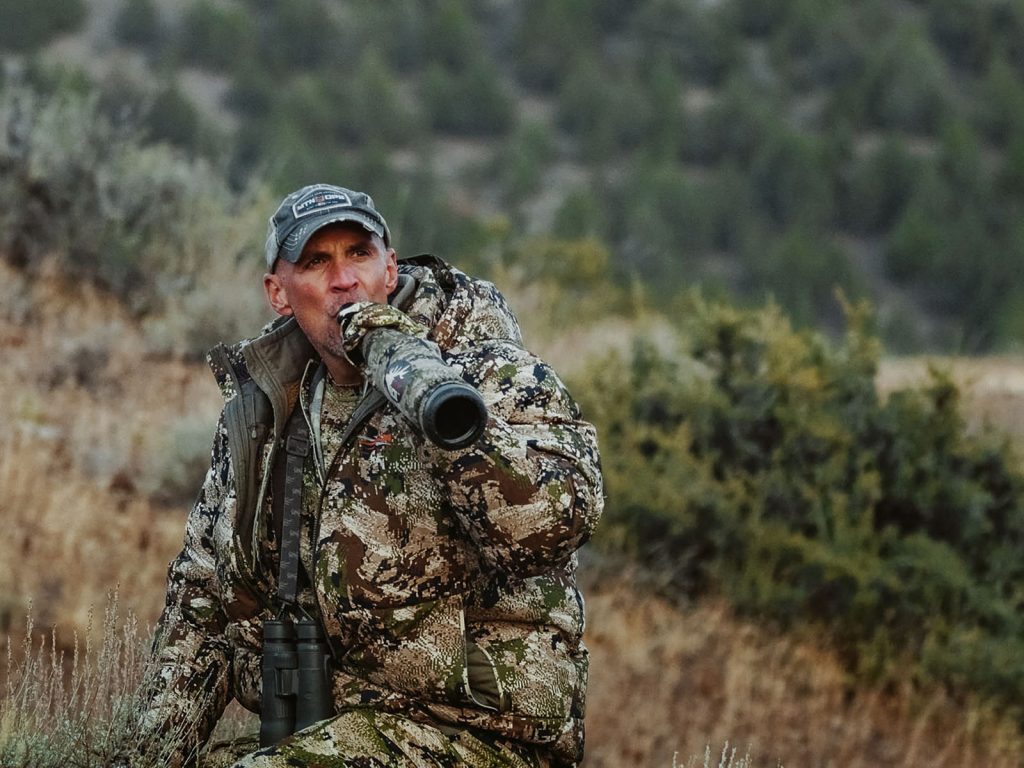
Again, remember what the situation is. You are close to a bull elk and he doesn’t know anyone is there. All of a sudden, he hears a sweet sounding cow who he can only assume is all alone. His natural response is to pick her up. As he’s telling her about how cool he is, the cow’s boyfriend – who the bull didn’t even know is there – starts screaming at him and insulting him and challenging him to come and fight for the girl. I’ve watched former college roommates cover insane distances in the blink of an eye in similar circumstances! When someone challenges you and embarrasses you from right up in your face, the flight response is usually not even an option….it is all fight at that point!
ALWAYS GET IN THE LAST WORD
There are three keys to this calling strategy that make it effective: being close with the element of surprise, hitting the high note, and lastly, always getting in the last word. I always start my calling off with cow calls. I want to elicit a response from the bull, and then, I want to extend the challenge. If I bugle first, that leaves the door open for the bull to respond with an aggressive challenge, and he’s basically telling me, “Hey, why don’t you come up here and we can settle this.” In so doing, he has placed the ball in my court and will sit back and wait for me to make the next move. After a few rounds of this with no action on my part, the bull assumes that I am all talk and afraid to approach him, and he turns and leaves. However, if I get the bull to bugle to my cow calls, I am in the driver’s seat and able to issue a challenge to the bull. Now, the ball is in his court, and he has to respond to my challenge. If a bull bugles, I always want to respond immediately with an aggressive challenge bugle. If he responds immediately to my challenge, I will cut him off with another challenge. I always want to be the last one to bugle. Here is a short video that will walk you through – and demonstrate how to use – the Challenge Bugle sequence:ADDITIONAL THOUGHTS
I know what many of you are probably thinking….yeah, that works on big, aggressive bulls, but a timid, raghorn bull on public land is going to turn and run away. Right? Wrong. Even a young bull is filled with a natural desire to breed and to fight, as well as an overdose of testosterone. The emotional response to breed and to fight is hardwired into even the most timid, young bulls, and I have had spikes and raghorns come running in to this calling sequence on a regular basis. They do come in slightly more timid than the bigger bulls, but they still come in.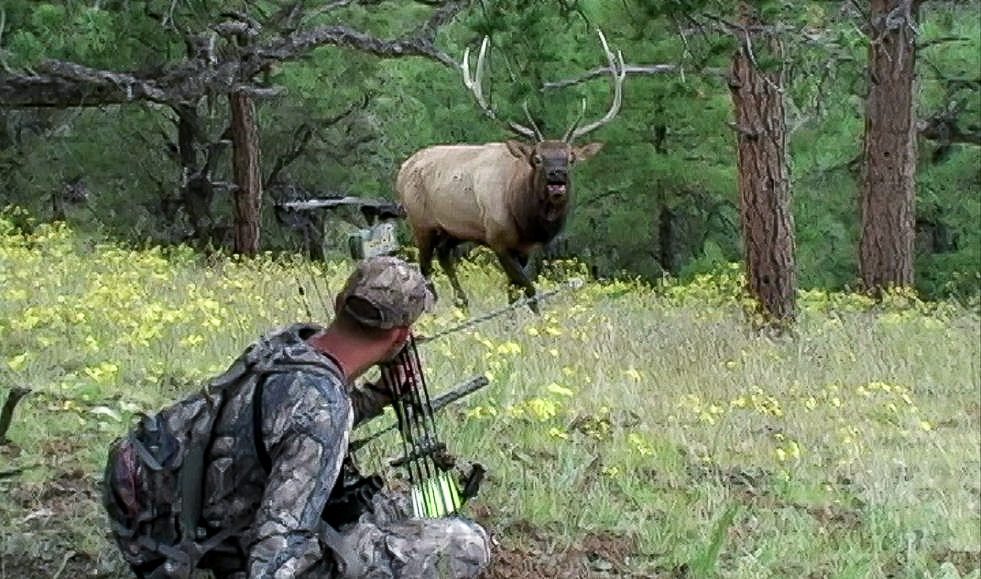
The really awesome part about this tactic for calling in elk is that it works throughout the rut. I’ve had success with it in late August, when you don’t usually think elk are going to be responsive to aggressive calling. It’s worked during the peak of the rut, when herd bulls are usually pre-occupied with just their harem. The reason it works so consistently is simple: Elk respond to emotion. Furthermore, there are really only two emotions elk respond to: the desire to breed and the desire to fight. This calling strategy plays to both emotions, and adds every other element I can think of that will trigger an elk to respond (close proximity, surprise, aggression, embarrassment, etc.).
Over the years I've learned that giving a bull one of these "challenges" doesn't always work, especially when initiated at longer distances. Inside 100-150 yards, however, it has become my go-to strategy and has proven to be fatal on multiple occasions. The standard advice of keeping the wind in your favor, setting up with good shooting lanes, and hoping for a little luck still applies just as strongly as ever, but the attitude – the emotion - of your calling will very often be the factor that ultimately makes the difference!
If the bull goes silent during the setup, I still try to only utilize cow calls to get him to respond. As I mentioned before, if he hasn’t responded for 2-3 series of cow calls (after 2-3 minutes), when he does respond, I immediately go for the jugular and try to start a fight. I will sometimes sit there for 8-10 minutes just giving cow calls if the bull isn’t responding. There are times when the bull will come in silently, and I don’t want to get so aggressive that I end up bumping a silent bull that is making his way in to the setup. However, my patience usually doesn’t allow me to sit there much longer. Besides, I’m looking for the one bull that is fired up that day….if this one isn’t the one, I need to push the envelope and make something happen, or go find one that is ready to fight!
PERSISTENCE
Speaking of pushing the envelope, be persistent. If you are trying to call in a bull and he’s just not cooperating, don’t give up. Perseverance is just as critical in calling in a bull as it is in locating a bull. If I am calling to a bull and he hasn’t completely gone quiet or left the country, I will keep pushing him. Sometimes it’s a matter of following him to a place where he feels more comfortable coming in, other times it’s simply following him until he’s tired of being pestered.
Several years ago, I missed a shot at a nice 6X7 bull less than a half-mile from the truck. As soon as I missed, the bull knew something was wrong, but he didn’t wind me and continued to bugle as he retreated to his cows. My good friend, David Burdette, was set up calling from behind, and as I took off after the bull, I had to resort to doing the calling. David heard that I was on the move, and started following me and the bull up the mountain, adding some bugling to the fighting the bull and I were doing.
The elk were heading up the mountain to their bedding area, and the wind was still coming solidly down the mountain. The bull was somewhat shaken up from his near-death experience, but he never saw or smelled me during that first setup, so I pushed on. Three different times I was able to get the bull to turn and come back to run me off, but each time I was left without a shooting lane to get another shot. After a couple of hours, I knew the thermals would be changing at any time. I moved over 200 yards or so and did my best to keep up with the bull who was trailing the rest of the herd.
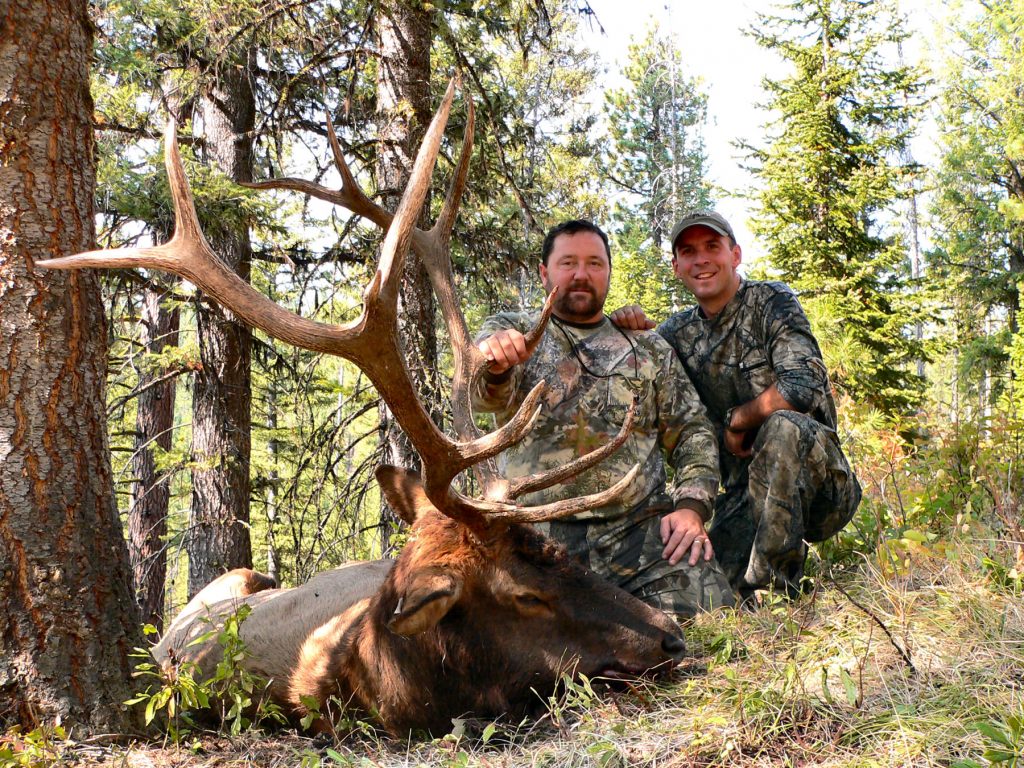
Finally, the elk reached their bedding area and the bull had simply had enough of my pestering.
David bugled from several hundred yards behind me, and the bull stopped on the ridge across from me and responded. Out of breath, I mustered an aggressive Challenge Bugle, and the bull came unglued. There was fire in his eyes, and I had trouble stopping the bull as he trotted into the lane just below me. I did stop him just in time, and he only ran 40 yards before piling up on the hillside below me. I bugled three times to signal to David that I had finally got it done. After 2-3 minutes, David came huffing and puffing up the mountain, soaked in sweat and gasping for air. Expecting a big bear hug and a congratulations, I was a little startled when he walked up and punched me rather firmly in the shoulder. Still out of breath, he gasped, “What the heck was wrong with shooting that bull down by the truck?!?!”
It’s true, the 1/2-mile pack would have been much more pleasant than the nearly 3 miles we ended up having to pack it. But, that’s not my point. My point is, stick with it. Be persistent and don’t give up. If the elk is still bugling, keep pushing on. It doesn’t always happen on the first bugle or the first setup.
With this detailed explanation of my go-to elk calling strategy, I do recognize there is an encyclopedia of additional elk calling tactics that can and do work. As I mentioned in the beginning of this Chapter, I feel my go-to tactic is the most simple, efficient calling tactic I’ve found for consistently getting elk to come in to calls. But, I also recognize the need to mix things up from time to time, and I certainly agree that different elk will respond to different tactics on different days. There will be times when you might need to try some different calling tactics, or add something to this tactic to get a bull to come in.
To continue reading about Alternate Calling Tactics, Click ‘Next Chapter’ Below to go to Chapter 3: Calling An Audible





